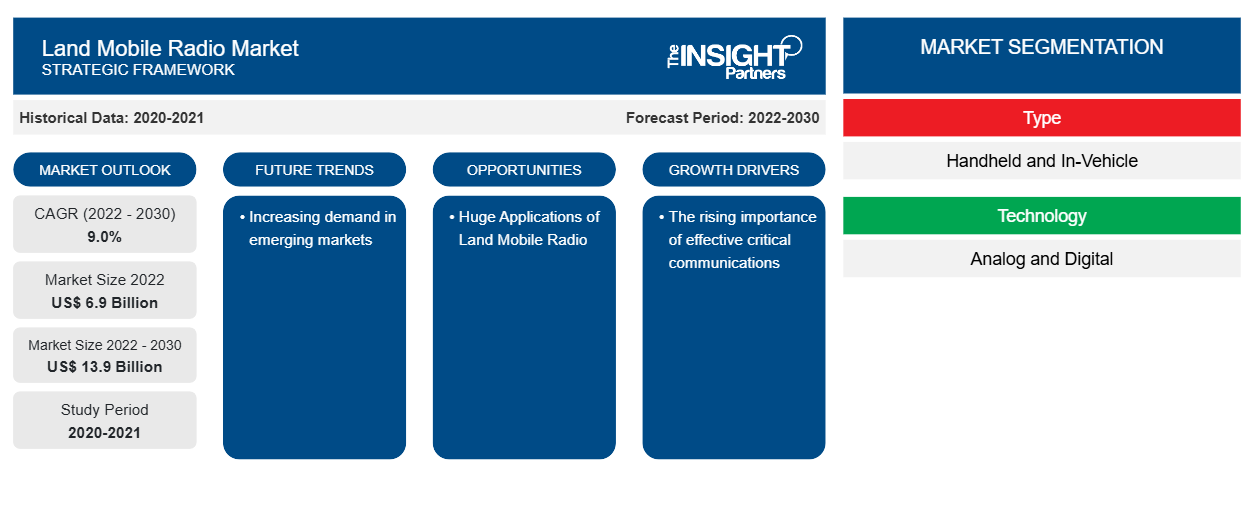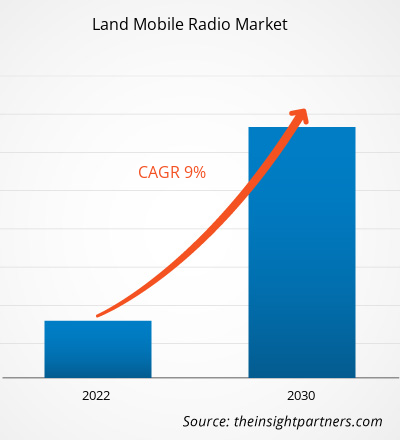陆地移动无线电市场规模预计将从 2022 年的 69 亿美元增至 2030 年的 139 亿美元,2022 年至 2030 年的复合年增长率预计为 9.0%。新兴市场的需求不断增长可能仍将是市场的一个主要趋势。
陆地移动无线电市场分析
陆地移动无线电系统是固定或便携式语音通信系统 ,由双向无线电 收发器、音频发射器和接收器组成。这些系统可供公共安全组织(例如消防队和救护车)、执法机构(例如警察和州警)和其他政府机构使用。它们被分配了专用频率。商业陆地移动无线电系统可用于商业、工业和陆地运输业务,但大多数频率与其他用户共享。由于在甚高频 (VHF) 或超高频 (UHF) 频段使用的天线适合安装在车辆或手持收发器上,因此陆地移动无线电系统使用短波长信道。发射器功率通常限制在几瓦,提供 4 至 32 公里的可靠工作范围,具体取决于地形。安装在山峰、丘陵或高层建筑上的中继器可以增加覆盖范围。
陆地移动无线电市场概览
陆地移动无线电系统是固定或便携式语音通信系统 ,由双向无线电 收发器、音频发射器和接收器组成。这些系统可供公共安全组织(例如消防队和救护车)、执法机构(例如警察和州警)和其他政府机构使用。它们被分配了专用频率。商业陆地移动无线电系统可用于商业、工业和陆地运输业务,但大多数频率与其他用户共享。由于在甚高频 (VHF) 或超高频 (UHF) 频段使用的天线适合安装在车辆或手持收发器上,因此陆地移动无线电系统使用短波长信道。发射器功率通常限制在几瓦,提供 4 至 32 公里的可靠工作范围,具体取决于地形。安装在山峰、丘陵或高层建筑上的中继器可以增加覆盖范围。
定制此报告以满足您的需求
您可以免费定制任何报告,包括本报告的部分内容、国家级分析、Excel 数据包,以及为初创企业和大学提供优惠和折扣
- 获取此报告的关键市场趋势。这个免费样品将包括数据分析,从市场趋势到估计和预测。
陆地移动无线电市场驱动因素和机遇
有效关键沟通对市场有利的重要性日益提升
有效的沟通对于公共安全响应者来说至关重要,他们必须在控制中心保持连接,同时还要在应对情况时实时获取情况信息。为了应对关键的通信操作,LMR 技术正在不断进步。陆地移动无线电技术已从传统的模拟语音服务(如双向通信)发展为具有集群和数字功能的复杂系统,这些系统可实现群组呼叫、快速语音呼叫设置、高质量音频和保证优先访问最终用户等功能。随着犯罪、恐怖主义和自然灾害的增加,行业需要采用新技术来实现快速有效的实时反应。TETRA 是最广泛使用的陆地移动无线电标准之一,它已经发展起来,现在它提供高频谱效率并在标准化频谱上运行。它还包括卓越的重要通信特性,例如安全性、快速呼叫启动时间、语音呼叫功能集和高速数据服务。它用于现有和新的市场领域,例如公共安全和商业应用。随着安全威胁的不断增加以及对更高效率、跨机构协调和更好的信息共享的需求,开发高效的公共安全通信网络已成为各组织的首要任务,从而推动全球 陆地移动无线电市场的 增长。
陆地移动无线电的巨大应用
陆地移动无线电系统是指基于陆地的专业一键通无线通信系统。陆地移动无线电系统通常由手持便携式无线电、固定基站和中继器、车载移动无线电和网络基础设施组成。陆地移动无线电系统被公共安全组织(如警察、消防员和其他应急响应组织)广泛用于关键通信。除了公共安全部门外,陆地移动无线电系统还广泛用于工业、公用事业、交通、安全、物流、军事等各个行业的商业企业。因此,陆地移动无线电的大量应用将推动市场增长。
陆地移动无线电市场报告细分分析
有助于得出陆地移动无线电市场分析的关键部分是类型、技术、频率和应用。
- 根据类型,陆地移动无线电市场分为手持式和车载式。手持式部分将在 2022 年占据相当大的市场份额。
- 根据技术,市场分为模拟和数字。数字部分进一步细分为 TETRA、DMR、P25 等。数字部分在 2022 年占据了最大的市场份额。
- 就频率而言,市场细分为 25–174 VHF、200–512 UHF 和 700 MHz 及以上。
- 就应用而言,市场分为商业、工业、公共安全和政府、以及军事。
陆地移动无线电市场份额(按地区)分析
陆地移动无线电市场报告的地理范围主要分为五个地区:北美、亚太、欧洲、中东和非洲、南美和中美。
北美陆地移动无线电市场分为美国、加拿大和墨西哥。2022 年,美国占据了最大的市场份额。这些设备在美国的主要客户是政府官员及其寻求用于军事和商业应用的高级加密解决方案的主要承包商。美国各地军事和商业部门的安全人员使用不同类型的无线电系统,包括以不同频率运行的车载、手持和机载无线电系统,用于语音和数据通信。在北美运营的公司正在根据该地区国家的需求不断开发先进的通信解决方案。由于宽带技术的发展,美国市场正在经历现代化,从而迅速过渡到宽带通信系统。美国陆军选择哈里斯公司提供 2 通道车载无线电系统 AN/VRC-118,该系统使用美国国防部开发的宽带网络波形。在商业领域,寻求广域和跨州陆地移动无线电系统的大型公用事业公司促进了美国整体陆地移动无线电市场的增长。
陆地移动无线电市场区域洞察
Insight Partners 的分析师已详细解释了预测期内影响陆地移动无线电市场的区域趋势和因素。本节还讨论了北美、欧洲、亚太地区、中东和非洲以及南美和中美洲的陆地移动无线电市场细分和地理位置。

- 获取陆地移动无线电市场的区域特定数据
陆地移动无线电市场报告范围
| 报告属性 | 细节 |
|---|---|
| 2022 年市场规模 | 69亿美元 |
| 2030 年市场规模 | 139亿美元 |
| 全球复合年增长率(2022 - 2030 年) | 9.0% |
| 史料 | 2020-2021 |
| 预测期 | 2022-2030 |
| 涵盖的领域 | 按类型
|
| 覆盖地区和国家 | 北美
|
| 市场领导者和主要公司简介 |
|
市场参与者密度:了解其对商业动态的影响
陆地移动无线电市场正在快速增长,这得益于终端用户需求的不断增长,而这些需求又源于消费者偏好的不断变化、技术进步以及对产品优势的认识不断提高等因素。随着需求的增加,企业正在扩大其产品范围,进行创新以满足消费者的需求,并利用新兴趋势,从而进一步推动市场增长。
市场参与者密度是指在特定市场或行业内运营的企业或公司的分布情况。它表明在给定市场空间中,相对于其规模或总市场价值,有多少竞争对手(市场参与者)存在。
在陆地移动无线电市场运营的主要公司有:
- L3Harris技术公司
- 摩托罗拉系统公司
- 泰特通讯有限公司
- 泰雷兹公司
- Simoco 无线解决方案有限公司
- JVCKENWOOD 公司
免责声明:上面列出的公司没有按照任何特定顺序排列。

- 获取陆地移动无线电市场顶级关键参与者的概览
陆地移动无线电市场新闻和最新发展
陆地移动无线电市场通过收集一手和二手研究后的定性和定量数据进行评估,其中包括重要的公司出版物、协会数据和数据库。陆地移动无线电市场的一些发展情况如下:
- Mobix Labs 推出了 MBX3110 SP10T 高功率射频 (RF) 开关。这款高功率开关支持 LMR 应用,并且用途广泛,可用于国防系统和先进的无线基础设施等多个领域。(来源:Mobix Labs,新闻稿,2024 年 5 月)
- 美国陆军授予泰雷兹 SA 一份价值 1 亿美元的合同,作为 Leader 计划下第五批手持、背负和小型 (HMS) 无线电。该合同包括 4,000 台 AN/PRC-148D 2 通道 IMBITR 装置,通过先进的移动自组织网络 (MANET) 波形增强作战人员的战场网络能力。(来源:泰雷兹 SA,新闻稿,2022 年 10 月)
陆地移动无线电市场报告覆盖范围和交付成果
“陆地移动无线电市场规模和预测(2020-2030 年)”报告对以下领域进行了详细的市场分析:
- 范围内涵盖的所有主要细分市场的全球、区域和国家层面的陆地移动无线电市场规模和预测
- 陆地移动无线电市场趋势,以及驱动因素、限制因素和关键机遇等市场动态
- 详细的 PEST/波特五力分析和 SWOT 分析
- 陆地移动无线电市场分析涵盖主要市场趋势、全球和区域框架、主要参与者、法规和最新市场发展
- 行业格局和竞争分析,涵盖市场集中度、热图分析、知名参与者以及陆地移动无线电市场的最新发展
- 详细的公司简介
- 历史分析(2 年)、基准年、预测(7 年)及复合年增长率
- PEST 和 SWOT 分析
- 市场规模价值/数量 - 全球、区域、国家
- 行业和竞争格局
- Excel 数据集



Report Coverage
Revenue forecast, Company Analysis, Industry landscape, Growth factors, and Trends

Segment Covered
This text is related
to segments covered.

Regional Scope
North America, Europe, Asia Pacific, Middle East & Africa, South & Central America

Country Scope
This text is related
to country scope.
常见问题
The land mobile radio market size is projected to reach US$ 13.9 billion by 2030.
North America is expected to dominate the land mobile radio market with the highest market share in 2022.
The rising importance of effective critical communications is the major factor driving the land mobile radio market.
The global land mobile radio market is expected to grow at a CAGR of 9.0% during the forecast period 2022 - 2030.
Increasing demand in emerging markets is anticipated to play a significant role in the global land mobile radio market in the coming years.
The leading players operating in the land mobile radio market are L3Harris Technologies Inc, Motorola Solutions Inc, Tait Communications Ltd, Thales SA, Simoco Wireless Solutions Ltd, JVCKENWOOD Corp, BK Technologies Corp, Hytera Communications Corp Ltd, Icom Inc, and Sepura Ltd.
Trends and growth analysis reports related to Electronics and Semiconductor : READ MORE..
The List of Companies - Land Mobile Radio Market
- L3Harris Technologies Inc
- Motorola Solutions Inc
- Tait Communications Ltd
- Thales SA
- Simoco Wireless Solutions Ltd
- JVCKENWOOD Corp
- BK Technologies Corp
- Hytera Communications Corp Ltd
- Icom Inc
- Sepura Ltd
The Insight Partners performs research in 4 major stages: Data Collection & Secondary Research, Primary Research, Data Analysis and Data Triangulation & Final Review.
- Data Collection and Secondary Research:
As a market research and consulting firm operating from a decade, we have published and advised several client across the globe. First step for any study will start with an assessment of currently available data and insights from existing reports. Further, historical and current market information is collected from Investor Presentations, Annual Reports, SEC Filings, etc., and other information related to company’s performance and market positioning are gathered from Paid Databases (Factiva, Hoovers, and Reuters) and various other publications available in public domain.
Several associations trade associates, technical forums, institutes, societies and organization are accessed to gain technical as well as market related insights through their publications such as research papers, blogs and press releases related to the studies are referred to get cues about the market. Further, white papers, journals, magazines, and other news articles published in last 3 years are scrutinized and analyzed to understand the current market trends.
- Primary Research:
The primarily interview analysis comprise of data obtained from industry participants interview and answers to survey questions gathered by in-house primary team.
For primary research, interviews are conducted with industry experts/CEOs/Marketing Managers/VPs/Subject Matter Experts from both demand and supply side to get a 360-degree view of the market. The primary team conducts several interviews based on the complexity of the markets to understand the various market trends and dynamics which makes research more credible and precise.
A typical research interview fulfils the following functions:
- Provides first-hand information on the market size, market trends, growth trends, competitive landscape, and outlook
- Validates and strengthens in-house secondary research findings
- Develops the analysis team’s expertise and market understanding
Primary research involves email interactions and telephone interviews for each market, category, segment, and sub-segment across geographies. The participants who typically take part in such a process include, but are not limited to:
- Industry participants: VPs, business development managers, market intelligence managers and national sales managers
- Outside experts: Valuation experts, research analysts and key opinion leaders specializing in the electronics and semiconductor industry.
Below is the breakup of our primary respondents by company, designation, and region:

Once we receive the confirmation from primary research sources or primary respondents, we finalize the base year market estimation and forecast the data as per the macroeconomic and microeconomic factors assessed during data collection.
- Data Analysis:
Once data is validated through both secondary as well as primary respondents, we finalize the market estimations by hypothesis formulation and factor analysis at regional and country level.
- Macro-Economic Factor Analysis:
We analyse macroeconomic indicators such the gross domestic product (GDP), increase in the demand for goods and services across industries, technological advancement, regional economic growth, governmental policies, the influence of COVID-19, PEST analysis, and other aspects. This analysis aids in setting benchmarks for various nations/regions and approximating market splits. Additionally, the general trend of the aforementioned components aid in determining the market's development possibilities.
- Country Level Data:
Various factors that are especially aligned to the country are taken into account to determine the market size for a certain area and country, including the presence of vendors, such as headquarters and offices, the country's GDP, demand patterns, and industry growth. To comprehend the market dynamics for the nation, a number of growth variables, inhibitors, application areas, and current market trends are researched. The aforementioned elements aid in determining the country's overall market's growth potential.
- Company Profile:
The “Table of Contents” is formulated by listing and analyzing more than 25 - 30 companies operating in the market ecosystem across geographies. However, we profile only 10 companies as a standard practice in our syndicate reports. These 10 companies comprise leading, emerging, and regional players. Nonetheless, our analysis is not restricted to the 10 listed companies, we also analyze other companies present in the market to develop a holistic view and understand the prevailing trends. The “Company Profiles” section in the report covers key facts, business description, products & services, financial information, SWOT analysis, and key developments. The financial information presented is extracted from the annual reports and official documents of the publicly listed companies. Upon collecting the information for the sections of respective companies, we verify them via various primary sources and then compile the data in respective company profiles. The company level information helps us in deriving the base number as well as in forecasting the market size.
- Developing Base Number:
Aggregation of sales statistics (2020-2022) and macro-economic factor, and other secondary and primary research insights are utilized to arrive at base number and related market shares for 2022. The data gaps are identified in this step and relevant market data is analyzed, collected from paid primary interviews or databases. On finalizing the base year market size, forecasts are developed on the basis of macro-economic, industry and market growth factors and company level analysis.
- Data Triangulation and Final Review:
The market findings and base year market size calculations are validated from supply as well as demand side. Demand side validations are based on macro-economic factor analysis and benchmarks for respective regions and countries. In case of supply side validations, revenues of major companies are estimated (in case not available) based on industry benchmark, approximate number of employees, product portfolio, and primary interviews revenues are gathered. Further revenue from target product/service segment is assessed to avoid overshooting of market statistics. In case of heavy deviations between supply and demand side values, all thes steps are repeated to achieve synchronization.
We follow an iterative model, wherein we share our research findings with Subject Matter Experts (SME’s) and Key Opinion Leaders (KOLs) until consensus view of the market is not formulated – this model negates any drastic deviation in the opinions of experts. Only validated and universally acceptable research findings are quoted in our reports.
We have important check points that we use to validate our research findings – which we call – data triangulation, where we validate the information, we generate from secondary sources with primary interviews and then we re-validate with our internal data bases and Subject matter experts. This comprehensive model enables us to deliver high quality, reliable data in shortest possible time.


 获取此报告的免费样本
获取此报告的免费样本